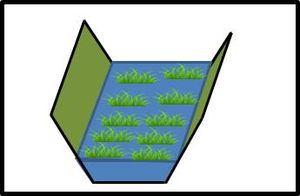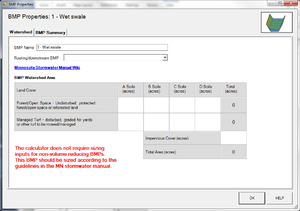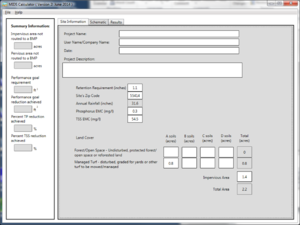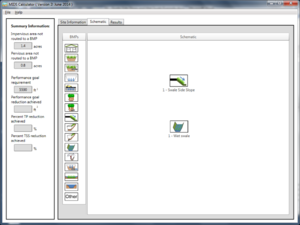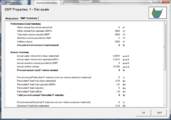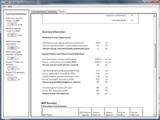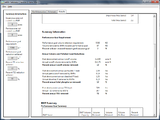
Requirements, recommendations and information for using wet swale as a BMP in the MIDS calculator
A wet swale does not reduce stormwater volume. While this BMP does not provide stormwater volume reduction towards the instantaneous performance goal or on an annual basis, it does provide an annual pollutant load reduction for TSS. If runoff to the wet swale flows over a side slope through sheet flow, then a swale side slope BMP should be used in combination with the Wet swale BMP.
Contents
Version 4 changes
- The USER must enter a bypass percent for this BMP. See the guidance for determining bypass percent.
- The TSS removal rate for wet swale was reduced from 68% to 35%. This is based on data from the International BMP Database.
MIDS calculator user inputs for wet swale
For the wet swale BMP, the only design parameter that must be input by the user is BMP Watershed Area.
- Watershed tab:
- BMP Name: this cell is auto-filled but can be changed by the user.
- Routing/downstream BMP: if this BMP is part of a treatment train and water is being routed from this BMP to another BMP, the user selects the name of the BMP to which water is being routed from the dropdown box. All water must be routed to a single downstream BMP. Note that the user must include the BMP receiving the routed water in the Schematic or the BMP will not appear in the dropdown box.
- BMP Watershed Area: BMP watershed areas are the areas draining directly to the BMP. Values can be added for four soil types (Hydrologic Soil Groups (HSG) A, B, C, D) and for three Land Cover types (Forest/Open Space, Managed Turf, and Impervious Cover). The surface area of the BMP should be included as a managed turf land cover under the hydrologic soils group of the native soils located under the BMP. Units are in acres.
- BMP Summary Tab: The BMP Summary tab summarizes the volume and pollutant reductions provided by the specific BMP. It details the performance goal volume reductions and annual average volume, dissolved P, particulate P, and TSS load reductions. Included in the summary are the total volume and pollutant loads received by the BMP from its direct watershed, from upstream BMPs, and a combined value of the two. Also included in the summary are the volume and pollutant load reductions provided by the BMP, along with the volume and pollutant loads that exit the BMP through the outflow. This outflow load and volume is what is routed to the downstream BMP, if one is defined in the Watershed tab. Finally, percent reductions are provided for the percent of the performance goal achieved, percent annual runoff volume retained, total percent annual particulate phosphorus reduction, total percent annual dissolved phosphorus reduction, total percent annual TP reduction, and total percent annual TSS reduction. Note that a Wet swale may achieve TSS removal, but no volume or phosphorus reduction is achieved by this type of BMP.
Routing stormwater runoff to swales and swale side slopes in the MIDS Calculator
The Minimal Impact Design Standards (MIDS) Calculator separates side slopes and the main channel of swales into separate practices. This creates the potential for inaccurately routing water, since in reality side slopes and main channels are part of a single swale system. This page provides guidance for routing water to swales in the MIDS Calculator.
Swale configuration in the MIDS Calculator
The MIDS Calculator separates swale side slopes and swale main channels into separate best management practices. This is because infiltration and pollutant retention calculations differ for the side slope and the main channel. Descriptions of modeling assumptions and calculations are found at the following links.
The primary difference between side slopes and main channels is due to increased potential for infiltration in a main channel resulting from different configurations. Specifically, infiltration in a main channel is affected by length of the swale, presence or absence of impermeable check dams, and presence or absence of engineered media. These configurations are either not available for side slopes or have limited impact on infiltration.
Potential swale configurations
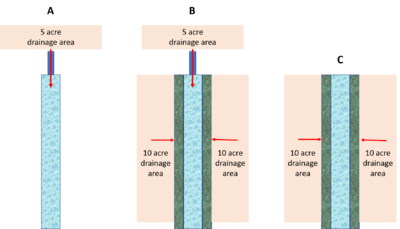
In reality, swale side slopes and main channels are part of a single swale practice. There are three possible configurations of swales. Configuring and routing water to them correctly is essential to correctly modeling swales.
- Swale main channels with direct discharge to it and no side slopes. This situation is rare, but there may be situations where water is discharged, such as from a pipe, directly into a swale and the swale has no side slopes.
- Swale main channels with direct discharge to it and one or more side slopes.
- Swale main channels with one or more side slopes and no direct discharges to the swale.
These configurations are shown in the adjacent image.
Configuring and routing water to a swale practice
- Swale main channels with direct discharge to it and no side slopes. In this situation, only the swale main channel is used in the MIDS Calculator.
- If the discharge water to the swale main channel is coming directly from another treatment practice, such as a bifiltration practice (e.g. bioretention with an underdrain), do not enter any contributing pervious or impervious acreage to the swale main channel. Make sure the upstream practice is being routed to the swale main channel.
- If the discharge water to the swale main channel is not from another treatment practice, enter the impervious and pervious acres contributing to this discharge into the Watershed tab for the swale BMP properties.
- If the discharge water to the swale main channel contains both treated and untreated water, enter only acreages contributing to the untreated discharge. Make sure the upstream BMP for the treated water is routed to the swale main channel.
- Swale main channels with direct discharge to it and one or more side slopes. For this situation, apply the above methodology to the direct discharge to the main channel. For the side slope, enter pervious and impervious acres to the Watershed tab for the swale side slope and route the side slope to the main channel. DO NOT ROUTE THESE ACREAGES TO THE MAIN CHANNEL. If there is more than one side slope, use multiple side slopes routed to the one main channel.
- Swale main channels with one or more side slopes and no direct discharges to the swale. If all the discharge to the main channel is from swale side slopes, enter pervious and impervious acres to the Watershed tab for the swale side slope and route the side slope to the main channel. DO NOT ROUTE THESE ACREAGES TO THE MAIN CHANNEL. If there is more than one side slope, use multiple side slopes routed to the one main channel.
Methodology
Required Treatment Volume
Because a Wet swale does not reduce stormwater volume, there is no Required treatment volume associated with this BMP.
Volume Reduction
This BMP does not provide volume reduction towards the performance goal.
Pollutant Reduction
Pollutant load reductions are calculated on an annual basis. Fixed removal rates of 35 percent TSS, 0 percent particulate phosphorus, and 0 percent dissolved phosphorus are applied to water that travels through the wet swale.
NOTE: The user can modify event mean concentrations (EMCs) on the Site Information tab in the calculator. Default concentrations are 54.5 milligrams per liter for total suspended solids (TSS) and 0.3 milligrams per liter for total phosphorus (particulate plus dissolved). The calculator will notify the user if the default is changed. Changing the default EMC will result in changes to the total pounds of pollutant reduced.
Routing
A wet swale can be routed to any other BMP except for a green roof and a swale side slope or any BMP that would cause water to be rerouted back to the wet swale. All BMPs can be routed to a wet swale.
Assumptions for Wet swale
The following general assumption applies in calculating the credits for a wet swale. If this assumption is not followed the pollutant reduction credits cannot be applied.
- The wet swale has been properly designed, constructed, and will be properly maintained according to specifications for filtration systems.
On the Watershed tab for this BMP in the MIDS calculator, the following warning is given: “The calculator does not require sizing inputs for non-volume reducing BMPs. This BMP should be sized according to the guidelines in the Minnesota Stormwater Manual.” See design criteria and construction specifications.
Swale Side Slope and Wet Swale Example
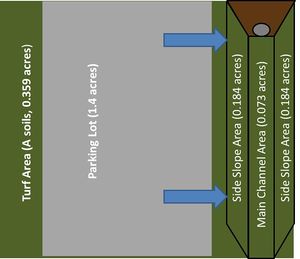
The runoff from a 1.4 acre parking lot surrounded by 0.359 acre of pervious turf area flows through sheet flow over one of the side slopes of a swale and into the main channel of the swale, which consists of a wet swale. The soils across the area have a unified soils classification of SW (HSG type A soil). A second side slope associated with the wet swale does not receive runoff from impervious surfaces. Each of the swale side slopes are 800 feet long by 10 feet wide with a side slope of 5H:1V. The maintenance on the swale side slopes call for mowing once a year. The following steps detail how this system would be set up in the MIDS calculator.
Step 1: Determine the watershed characteristics of your entire site. For this example we have a 2.2 acre site with 1.4 acres of impervious area (parking lot) and 0.8 acre of pervious area in type A soils. The pervious area includes the turf area and the area of the swale side slopes and main channel (wet swale).
Step 2: Fill in the site specific information into the Site Information tab. This includes entering a ZIP Code (55414 for this example) and the watershed information from Step 1. The Managed Turf area includes the turf area, the area of the side slopes, and the area of the main channel. ZIP code and impervious area must be filled in or an error message will be generated. Other fields on this screen are optional.
Step 3: Go to the Schematic tab and drag and drop a Swale Side Slope and a Wet Swale icon into the Schematic window
Step 4: Determine the watershed characteristic for each of the BMP components. For this example, the watershed of the swale side slope includes 1.4 acres of impervious area and 0.543 acre of pervious area (0.359 acre of turf area plus 0.184 acre of swale side slope). The watershed of the wet swale includes the pervious area of the wet swale (0.073 acre) and the pervious area of the other swale side slope (0.184 acre) for a total pervious area of 0.257 acre. Since no impervious area is being routed to the second side slope, the area can be included in the direct watershed area of the wet swale. However, the second swale side slope could be also placed in the calculator as a separate BMP.
Step 5: Open the BMP properties for the swale side slope by right clicking on the Swale Side Slope icon and selecting Edit BMP properties, or by double clicking on the Swale Side Slope icon.
Step 6: if help is needed, click on the Minnesota Stormwater Manual Wiki link or the Help button to review input parameter specifications and calculations pertinent to the Swale Side Slope BMP.
Step 7: Fill in the specific BMP watershed information (1.4 acres of impervious and 0.543 acre of Managed Turf on A Soils. Route the swale side slope BMP to the wet swale BMP.
Step 8: Enter the BMP design parameters into the BMP Parameters tab. This Swale Side Slope example would require the following entries:
- Side slope [H:V]: 5:1
- Flow path length: 10 feet
- Channel length: 800 feet
- Underlying soil – Hydrologic Soil Group: 4 SW (HSG A, 1.63 in/hr) (selected in dropdown box)
- Manning’s n (vegetation): Native grass (selected in dropdown box)
- MIDS calculator screen shots of data input screens. Click on an image for enlarged view.
- MIDS calculator screen shots of results and summary tabs. Click on an image for enlarged view.
Step 9: Click on BMP Summary tab to view results for this BMP.
Step 10: Click on the OK button to exit the BMP properties screen. An arrow will appear showing that the swale side slope has been routed to the wet swale.
Step 11: Open the BMP Properties window for the swale main channel by right clicking on the Wet Swale icon and selecting Edit BMP properties, or by double clicking on the Wet Swale icon.
Step 12: Click on the Minnesota Stormwater Manual Wiki link or the Help button to review input parameter specifications and calculations specific to the Wet Swale.
Step 13: Enter the watershed information for the Wet swale in the Watershed tab (0.257 acre for Pervious Turf on A Soil, which includes the area of the main channel and the other side slope).
Step 14: Design parameters are not required for the wet swale BMP. Click on BMP Summary tab to view results for this BMP.
Step 15: Click on the OK button to exit the BMP properties screen.
Step 16: Click on Results tab to see overall results for the site.
Information
- Construction specifications for filtration BMPs
- Information on operation and maintenance of filtration BMPs.
Links to MIDS pages
- Overview of Minimal Impact Design Standards (MIDS)
- Performance goals for new development, re-development and linear projects
- Design Sequence Flowchart-Flexible treatment options
- Community Assistance Package
- MIDS calculator
- Performance curves for MIDS calculator
- Training and workshop materials and modules
- Technical documents
This page was last edited on 23 November 2022, at 22:24.
